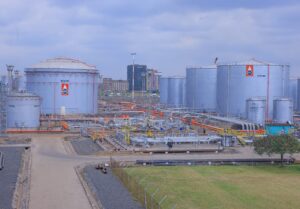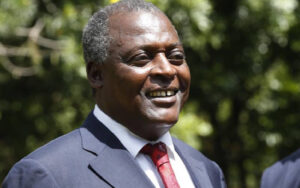Tear Gas has become a familiar sight during recent opposition demonstrations in Nairobi, as protesters voice their discontent over the rising cost of living and the legitimacy of President William Ruto‘s government.
While these protests are a legitimate expression of democratic rights, the use of tear gas has once again come into the spotlight, raising concerns about its impact on both demonstrators and law enforcement.
![Protesters running away from Tear gas at Kencom Nairobi, Kenya on 20/03/23 during Protests [Photo/Courtesy]](https://news.switchtv.ke/wp-content/uploads/2023/07/Copy-of-Cover-photo-20-1200x675.webp)
The history of tear gas dates back to 1914 when it was first invented by German scientists. Originally designed as a weapon during World War One, tear gas was later repurposed for crowd control by police departments worldwide.
Fritz Haber ushered the world of warfare into an unprecedented era. He brought about the use of chemical weapons. To be sure, there had been isolated incidents throughout history of soldiers using smoke, tear gas, or other means to aid their fight, but it was the work of a single man—a German chemist known for his humor, loyalty, and pleasant conversation—who brought about an entire industry. He was just one man, but he changed the world.
The active ingredients, oleum capsicum and capsaicin, cause victims to experience uncontrollable crying, breathing difficulties, and intense pain when dispersed in the air.
![Fritz Haber, the man who invented use of gas during warfare [Image source: Image courtesy of Fritz Haber]](https://news.switchtv.ke/wp-content/uploads/2023/07/test-1_bb06c45e-82ad-4b1a-aa05-ba88f596b58e.webp)
Tear gas has become a standard tool for law enforcement during large demonstrations and protests. The Kenyan authorities have employed water cannons and tear gas canisters to disperse crowds and maintain public order.
While these measures aim to prevent violence and protect public safety, they also raise concerns about the excessive use of force and potential harm to protesters.
During the ongoing Maandamano, or demonstrations, organized by opposition leader Raila Odinga, tear gas is being deployed as protesters marched against the high cost of living and questioned the legitimacy of President Ruto’s government.
Some demonstrators, familiar with the use of tear gas in past protests, even jokingly urged the police to ensure they had enough stock and not to use expired products.
![Masked soldiers charge through a cloud of gas during the WW1 [Photo/Courtesy]](https://news.switchtv.ke/wp-content/uploads/2023/07/soldier_charge.jpg)
Shadrack Omondi alias Omosh Jakabab a popular Tik Toker and member of Bunge La Mwananchi hilariously recounted yesterday how he pleaded with police officers to let him join the protests and get back to the cells.
He said after they refused to allow him to join the last week’s Wednesday Maandamano and yesterdays’ protests, he asked them to instead throw teargas in the cell at least to feel good.
“I will not talk much today as it is a demonstration day and I missed the demos. When I was in the cells I tried pleading with the police officers to at least let me go for the demos and be back to the cells,” he said.
Tear gas, however, poses health risks, especially to individuals with asthma or other respiratory conditions. Victims can suffer from severe respiratory complications, injuries, and burns, making it a controversial means of crowd control.
Read also: Children Hospitalized as Tear Gas Thrown in a Classroom During Azimio Protests
The use of tear gas also reflects the broader political crisis in Kenya, which has its roots in the highly contested election process of August 2022 and high costs of living. President Ruto’s victory sparked divisions, with the opposition claiming electoral malpractices and questioning the legitimacy of the government.
These demonstrations, organized now from Wednesday to Friday, have the potential to escalate tensions and threaten the stability of the nation.
Beyond the protests, Kenya faces significant challenges, including an ailing economy, rising inflation, and drought-induced food shortages in the northern regions. President Ruto’s administration promised immediate economic transformation, but the removal of vital subsidies on fuel and basic commodities has worsened the cost of living for many Kenyans.
![Protesters in Nairobi, Kenya [Photo/Courtesy]](https://news.switchtv.ke/wp-content/uploads/2023/07/6277b67fd34d4af08151d660ba3b4cd2.webp)
Moreover, political dynamics have seen opposition members defecting to the ruling party, UDA, strengthening its hegemony and raising concerns about the independence of the election commission.
While Maandamano politics have historically played a vital role in pushing for democratic rights and social justice in Kenya, it is crucial to strike a balance between the right to peaceful protest and maintaining public order.
In the end, Kenya’s political landscape demands constructive engagement, and the use of tear gas, while a tool for crowd control, should be deployed with caution to ensure the protection of citizens’ rights and safety.
As the nation navigates these challenges, it is essential to find lasting solutions that address the concerns of the people and work towards a more stable and prosperous future.
Subscribe to Switch TV















